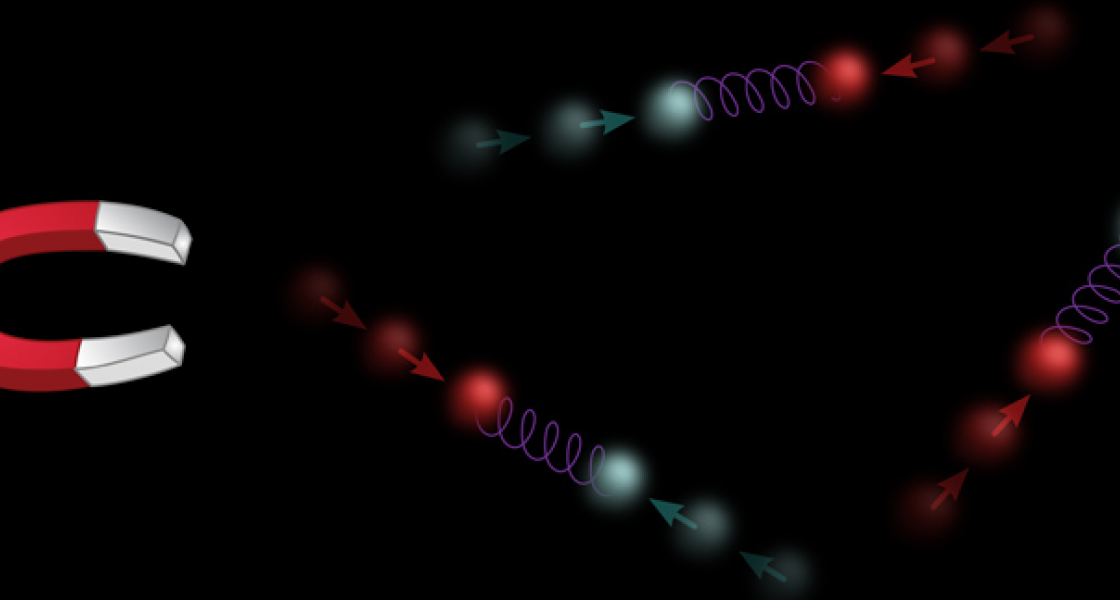The Jin and Ye groups recently crafted an entirely new form of matter — tens of thousands of ultracold polar molecules in their lowest energy state. The ground-state molecules are too cold to exist naturally anywhere in the Universe. But, like the Bose-Einstein condensates discovered in the mid-1990s, they promise to open the door to unprecedented explorations of the quantum world, including quantum information processing and exquisite precision measurement. That these molecules exist at all is a testament to the clever ideas and persistence of the Jin and Ye groups.
To make ultracold polar molecules, graduate student Kang-Kuen Ni (Jin group), research associate Silke Ospelkaus (Ye-Jin groups), graduate student Marcio Miranda (Ye group), and their colleagues at JILA, Temple University, and NIST's Joint Quantum Institute started with a cloud 40K and 87Rb atoms. They cooled the atoms to less than a millionth of a degree above absolute zero. The atoms in the ultracold cloud were about 10,000 Bohr radii apart, on average. One Bohr radius is the average distance of an electron orbiting a proton in a hydrogen atom. For atoms to form even the most loosely associated molecules, they must be more than 30 times closer together than in the gas. Fortunately, the Jin group figured out how to make this happen several years ago.
Lowering the magnetic field applied to an ultracold gas cloud can bring atoms close enough together to form large, fluffy, and loosely bound molecules. This process is known as Feshbach association. Ni, Ospelkaus, and their associates used it to make 40K87Rb molecules form in an ultracold cloud of 40K and 87Rb atoms. The atomic nuclei in these molecules were about 300 Bohr radii apart. The molecules were barely staying together, and the electron clouds around the nuclei weren’t yet interacting with each other as they would in a "normal" molecule. Rather, the mechanism holding these loosely bound molecules together was similar to that of clusters of water molecules found in nature.
For the atomic nuclei in the new 40K87Rb molecules to form tightly bound ground-state polar molecules, they had to move another 30 times closer to each other — close enough for their electron clouds to overlap and form true chemical bonds. The hard part was making sure that all the ultracold 40K87Rb molecules occupied their lowest-energy ground state. Such coherence was necessary for investigating the properties and quantum behavior of this new form of matter. Making the ground-state molecules was a challenge that occupied the Jin/Ye collaboration for nearly two years before Ni, Ospelkaus, and their fellow researchers recently achieved their goal.
To coherently transfer loosely bound 40K87Rb molecules into the ground state, the researchers locked two lasers to different lines in a femtosecond comb. They aimed the two coherent beams of laser light into the cloud of large, fluffy molecules so that the two laser beams interfered with each other, producing a pulse of light perfectly tuned to coherently transfer the molecules into one of two low-energy ground states. The nuclei of the higher-energy 40K87Rb ground-state molecules were about 15 Bohr radii apart, their electron clouds overlapped slightly, and they had a binding energy corresponding to a frequency of 7 THz. These polar molecules had small permanent electric dipole moments, but were fairly short lived.
In contrast, when the researchers created the lower-energy 40K87Rb ground-state molecules, the atomic nuclei were about 8 Bohr radii apart, their electron clouds overlapped to a greater degree, and they had a binding energy corresponding to a frequency of 125 THz. These molecules had electric dipole moments that were more than 10 times stronger than their higher-energy counterparts; they were also much longer lived. The creation of a long-lived quantum gas of ground-state polar molecules opened the door to future studies of dipolar Fermi gases and Bose-Einstein condensates. It has also shown once again the incredible power of frequency combs.
"In making our new ultracold 40K87Rb ground-state molecules, we have traversed an energy landscape that is equivalent to going from ultrasound, to radio wave, to infrared, and then to nearly visible," says Ye. "This is what a frequency comb can do — just like in an optical atomic clock!" - Julie Phillips




